Overview
- Brief Narrative
- Aquatint created by Leo Haas in 1966 based upon sketches made in 1945 shortly after the end of the war. It is based on scenes he witnessed in 1942 while an inmate of Theresienstadt ghetto-labor camp. It depicts inmates disembarking from a transport train in the pouring rain. Haas was an inmate of Terezin from September 1942-October 1944. Haas, 38, a Czech Jew and a professional artist, was arrested in 1939 in Ostrava in German occupied Czechoslovakia for being a Communist. He was deported to Nisko labor camp in Poland, then shipped back to Ostrava to do forced labor. In September 1942, he was sent to Theresienstadt ghetto-labor camp, where he became part of a tight knit group of artists determined to secretly document the misery and suffering of daily life in the ghetto. They hid their work in the camp, and much was recovered postwar. In summer 1944, they were accused by the Gestapo of smuggling their 'gruesome' work out of the camp and were arrested and tortured. In October, Haas was deported to Auschwitz, and a month later, to Sachsenhausen. In February 1945, he was transported to Mauthausen and then Ebensee. He was liberated there on May 4-5 by American troops.
- Artwork Title
- Die Vorletzte Station, Auschwitz 1944-45
- Alternate Title
- Next to Last Station, Auschwitz 1944-45
- Date
-
depiction:
1945
issue: 1966
- Geography
-
depiction:
Auschwitz (Concentration camp);
Oświęcim (Poland)
issue: Berlin (Germany : East)
- Credit Line
- United States Holocaust Memorial Museum Collection
- Signature
- front, on sheet below image, cursive, pencil : Leo Haas / 45(?)/66
- Contributor
-
Subject:
Leo Haas
Artist: Leo Haas
- Biography
-
Leo Haas was born on April 15, 1901, in Opava, Czechoslovakia, Austro-Hungary (now Czech Republic), formerly Troppau, an ethnic German region in Silesia. Leo was the oldest of four children in a Jewish family. He received art training while a youth. In 1919, Haas moved to Karlsruhe, Germany, to attend the Art Academy. He supported himself by working as a musician in local bars and by selling paintings. In 1922, he moved to Berlin where he studied with Emil Orlik and Wilhelm Jäckel. He absorbed the bold, dramatic styles of the Expressionist and Modernist movements flourishing in the city. He closely studied the work of graphic artists such as Goya and Toulouse-Lautrec in his 1923 travels in France. In 1925, he moved to Vienna, Austria, and established himself as a portraitist and newspaper caricaturist. In 1926, Haas returned to Opava, where he continued his career as painter and graphic artist, and set up a lithography studio. He also designed sets for a local theater troupe. Haas married Sophie Hermann in 1929. He was active in the Communist Party and several artist’s cooperatives. In the fall of 1938, Nazi Germany annexed the Sudetenland border of Czechoslovakia, which included Opava. Antisemitism surged after the takeover. Haas’s work was denounced as degenerate. After the Kristallnacht pogrom on early November, he and his wife moved to Ostrava to live with her parents.
In March 1939, Germany annexed the provinces of Bohemia and Moravia. German allies took over other regions and Czechoslovakia ceased to exist. There were widespread arrests of Jews, Communists, and prominent community members. In June, Jews were barred from most economic activity and property was confiscated. That September, Germany invaded Poland, the start of the Second World War. Haas was arrested for being a Communist and sent to Nisko labor camp near Lublin in German occupied Poland, where he drove supply wagons. He made portraits of SS camp personnel, in exchange for extra food and art supplies. He also secretly made drawings of camp life, of which over 100 were saved. The camp closed circa April 1940, and Haas returned to Ostrava. His wife fled, but Haas would not leave his father and sister. He did forced labor in the sewers. He met Erna Davidovitc, who became his second wife. Her parents were involved in underground activities, helping people and goods to cross borders illegally. After his father died in 1941, Haas joined in this work.
In August 1942, Haas was arrested by the Gestapo for smuggling. He was released but on September 30, Haas, Erna, her parents, and his sister Elvina were sent on transport Bm to Theresienstadt ghetto-labor camp. Men and women were housed separately at the camp. Haas was initially assigned to the railroad construction crew. But he was soon transferred to the technical department, headed by Bedrich Fritta, which created artwork, maps, charts, and other materials for the German SS camp administrators. Their work included architectural drawings which allowed them to move around the camp. It also gave them access to art supplies and Haas and a group of artist dedicated themselves to documenting the dreadful conditions of daily camp life, such as the search for food, prisoner transports, starving and hanged prisoners, and the many ill and dying residents. They met secretly at night to draw, as their accurate recording of camp activity was forbidden. Some artwork was smuggled out of the camp, while the remainder was hidden throughout the camp, in the walls, or buried. The technical department worked on the beautification project as the SS prepared the camp for a June 23, 1944, Red Cross visit.
Later the month, the SS discovered that drawings had been smuggled out of the camp. Haas, Fritta, Ungar, and Ferdinand Bloch were arrested. On July 17, they were sent to the Gestapo prison in the Small Fortress. Their families were arrested: Leo’s wife Erna, Fritta’s wife Hansi and their 3 year old son Tomas, Felix Bloch’s companion, Otto Ungar’s wife and 5 year old daughter. The art dealer Leo Strauss and his wife who helped smuggle the art were jailed. The men were taken to the basement, beaten, tortured, and interrogated by Adolf Eichmann and an officer named Günther. No one confessed. Haas later described how Eichmann “acted as if he were in the deepest soul affected by the slanderous accusations.” Gunther showed him a work with skeletal Jews fighting over potato skins and asked how he could make such a reality distorting drawing? Did he really think there was starvation the ghetto? The Red Cross did not find this?" The men were assigned to hard labor constructing railroad lines. Haas’s leg was injured, but with help from his friends was able to recover. In October 1944, they were convicted of distributing atrocity propaganda outside the camp.
Haas and Fritta were deported to Auschwitz, arriving there on October 28, 1944. Haas was assigned prisoner number 199885. Fritta died a week later of blood poisoning. For the next three weeks, Haas worked in Block 24, and made sketches for Dr. Josef Mengele. Subsequently, he was transferred to Sachsenhausen concentration camp and issued a new prisoner number 118029. He was assigned to the counterfeiting unit working on fake US currency. At the end of February 1945, Haas and his group were transferred to Mauthausen, and in April to Redl-Zipf and Schlier labor camps. On May 5, he was taken to Ebensee concentration camp where he was liberated the next day by American troops.
The war ended when Germany surrendered on May 7. When Haas was allowed to leave Ebensee, he returned to Theresienstadt, where he found all his hidden works, nearly 400, as well as many works by Fritta, Ungar, and Fleischmann. He reunited with his wife Erna, who had survived a year in solitary imprisonment and was in very poor health. Many of his friends had been killed. Fritta’s wife died of illness in Theresienstadt in February 1945. Bloch was beat to death by the Gestapo in the Small Fortress in October 1944. Ungar, the first of the group deported to Auschwitz, was eventually sent to Buchenwald where he died of typhus shorty after liberation in April 1945. His wife Frida and daughter Susanna survived. Leo Strauss and his wife were murdered in Auschwitz.
Haas and Erna adopted Tomas (1941-2015), the orphaned son of Bedrich Fritta and settled in Prague. Haas remained a committed Communist, taught at the Art Academy, and was a celebrated editorial cartoonist. A book of lithographs of his drawings of camp life was published in 1947. Haas also ensured that the work of Fritta and the others was publicly displayed to bear witness to the machinations of the Nazi’s planned final solution. Following Erna's death in 1955, Haas moved to East Berlin, where he was the editor of a satiric illustrated journal, Eulenspiegel. His third wife was named Inge. Haas also designed movie sets for DEFA and East German television. He exhibited his artwork widely, and continued to create works exploring the misery of life in the camps. Haas donated most of his wartime work to the Terezin Memorial and the State Jewish Museum in Prague. Haas, 78, died in 1983.
Physical Details
- Classification
-
Art
- Category
-
Prints
- Object Type
-
Concentration camps in art (lcsh)
- Physical Description
- Aquatint and drypoint on paper depicting an open traincar with gaunt, elderly, and infirm people crowded in the doorway, disembarking onto a platform filled with dead, ill, and collapsing inmates. A man with a Star of David armband assists those in the door and another helps an ill man seated on the ground. In the left foreground stands a uniformed guard in a hat and long overcoat, with a cane, enjoying a cigar. To the right is a partial view of another traincar unloading. It is pouring rain and the sky is black with dark gray clouds. Signed and dated by the artist on the sheet.
- Dimensions
- overall: Height: 14.625 inches (37.148 cm) | Width: 19.750 inches (50.165 cm)
pictorial area: Height: 8.625 inches (21.908 cm) | Width: 11.375 inches (28.893 cm) - Materials
- overall : wove paper, ink
- Inscription
- front, bottom right corner, pencil : 20
back, top right corner, blue marker : 16
Rights & Restrictions
- Conditions on Access
- No restrictions on access
- Conditions on Use
- Restrictions on use
Keywords & Subjects
- Topical Term
- Concentration camp inmates as artists--Biography. Concentration camps in art--Specimens. Holocaust survivors--Germany (East)--Biography. Holocaust, Jewish (1939-1945), in art--Specimens. Holocaust, Jewish (1939-1945)--Personal narratives. Jewish artists--Germany (East)--Biography. Political prisoners--Biography.
- Personal Name
- Haas, Leo, 1901-1983.
- Corporate Name
- Theresienstadt (Concentration camp)
Administrative Notes
- Legal Status
- Permanent Collection
- Provenance
- The aquatint was acquired by the United States Holocaust Memorial Museum in 2003.
- Funding Note
- The cataloging of this artifact has been supported by a grant from the Conference on Jewish Material Claims Against Germany.
- Record last modified:
- 2024-06-27 11:39:23
- This page:
- https://collections.ushmm.org/search/catalog/irn513925
Download & Licensing
In-Person Research
- By Appointment
- Request 21 Days in Advance of Visit
- Plan a Research Visit
- Request to See This Object
Contact Us
Also in Leo Haas collection
The collection consists of seventeen artworks created by Leo Haas depicting scenes from concentration camps based upon his experiences during the Holocaust.
Date: 1942-1945
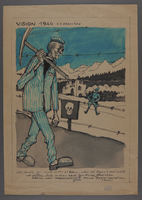
Leo Haas watercolor of a concentration camp prisoner in a blue striped uniform
Object
Watercolor by Leo Haas of an inmate in a bright blue and white striped uniform walking through Ebensee concentration camp based on his experiences as a prisoner in the camp. Haas, a Czech Jewish artist, was arrested in 1939 in Ostrava in German occupied Czechoslovakia for being a Communist. He was deported to Nisko labor camp in German occupied Poland, returned in April 1940, and assigned to forced labor. In August 1942, he was arrested for smuggling and, with his family, sent to Theresienstadt ghetto-labor camp. He and a few other artists secretly documented the horrendous conditions of camp life. In summer 1944, they were accused of smuggling their 'gruesome' work out of the camp and jailed and tortured in the Small Fortress. In October, Haas and Bedrich Fritta were deported to Auschwitz, where Fritta soon died. A month later, Haas was sent to Sachsenhausen to work in the counterfeiting unit. In February 1945, he was transported to Mauthausen and then Ebensee where he was liberated on May 6 by US troops.
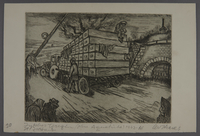
Leo Haas aquatint of a truck piled with coffins leaving Terezin
Object
Aquatint created by Leo Haas in 1966 based upon sketches made in 1942 based on scenes he witnessed while an inmate of Theresienstadt ghetto-labor camp. It depicts a truckload of coffins leaving Theresienstadt ghetto-labor camp during a typhus epidemic. Haas was an inmate of Terezin from September 1942-October 1944. Haas, 38, a Czech Jew and a professional artist, was arrested in 1939 in Ostrava in German occupied Czechoslovakia for begin a member of the Communist Party. He was deported to Nisko labor camp in Poland, then shipped back to Ostrava to do forced labor. In September 1942, he was sent to Theresienstadt ghetto-labor camp, where he became part of a tight knit group of artists determined to secretly document the conditions of daily life in the camp. In summer of 1944, they were accused by the Gestapo of smuggling their gruesome work out of the camp. Haas was arrested and tortured. In October, he was deported to Auschwitz, and a month later, to Sachsenhausen. In February 1945, he was transported to Mauthausen and then Ebensee. He was liberated there on May 4-5 by American troops.
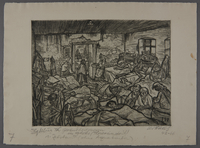
Leo Haas aquatint of a room overcrowded with ill inmates
Object
Aquatint created by Leo Haas in 1966 based upon sketches made in 1942 based on scenes he witnessed while an inmate of Theresienstadt ghetto-labor camp. It depicts patients in the overcrowded infirmary at Theresienstadt ghetto-labor camp. Haas was an inmate of Terezin from September 1942-October 1944. Haas, 38, a Czech Jew and a professional artist, was arrested in 1939 in Ostrava in German occupied Czechoslovakia for begin a member of the Communist Party. He was deported to Nisko labor camp in Poland, then shipped back to Ostrava to do forced labor. In September 1942, he was sent to Theresienstadt ghetto-labor camp, where he became part of a tight knit group of artists determined to secretly document the conditions of daily life in the camp. In summer of 1944, they were accused by the Gestapo of smuggling their gruesome work out of the camp. Haas was arrested and tortured. In October, he was deported to Auschwitz, and a month later, to Sachsenhausen. In February 1945, he was transported to Mauthausen and then Ebensee. He was liberated there on May 4-5 by American troops.
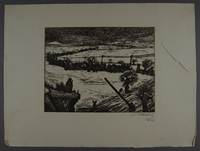
Leo Haas aquatint of a long line of people marching through the snow
Object
Aquatint created by Leo Haas in 1966 based upon sketches made in 1942 based on scenes he witnessed while an inmate of Theresienstadt ghetto-labor camp. It depicts the arrival of new inmates for Theresienstadt ghetto-labor camp. Haas was an inmate of Terezin from September 1942-October 1944. Haas, 38, a Czech Jew and a professional artist, was arrested in 1939 in Ostrava in German occupied Czechoslovakia for begin a member of the Communist Party. He was deported to Nisko labor camp in Poland, then shipped back to Ostrava to do forced labor. In September 1942, he was sent to Theresienstadt ghetto-labor camp, where he became part of a tight knit group of artists determined to secretly document the conditions of daily life in the camp. In summer of 1944, they were accused by the Gestapo of smuggling their gruesome work out of the camp. Haas was arrested and tortured. In October, he was deported to Auschwitz, and a month later, to Sachsenhausen. In February 1945, he was transported to Mauthausen and then Ebensee. He was liberated there on May 4-5 by American troops.

Leo Haas aquatint of frail sickly people on a ghetto street corner
Object
Aquatint created by Leo Haas in 1966 based upon sketches made in 1942 based on scenes he witnessed while an inmate of Theresienstadt ghetto-labor camp. It depicts a street scene with dilapidated shops and starving, ghoulish people, based on his experiences in Theresienstadt ghetto-labor camp. Haas was an inmate of Terezin from September 1942-October 1944. Haas, 38, a Czech Jew and a professional artist, was arrested in 1939 in Ostrava in German occupied Czechoslovakia for begin a member of the Communist Party. He was deported to Nisko labor camp in Poland, then shipped back to Ostrava to do forced labor. In September 1942, he was sent to Theresienstadt ghetto-labor camp, where he became part of a tight knit group of artists determined to secretly document the conditions of daily life in the camp. In summer of 1944, they were accused by the Gestapo of smuggling their gruesome work out of the camp. Haas was arrested and tortured. In October, he was deported to Auschwitz, and a month later, to Sachsenhausen. In February 1945, he was transported to Mauthausen and then Ebensee. He was liberated there on May 4-5 by American troops.

Leo Haas aquatint of an attic overcrowded with cold, exhausted people
Object
Aquatint created by Leo Haas in 1966 based upon sketches made in 1942 based on scenes he witnessed while an inmate of Theresienstadt ghetto-labor camp. It depicts the overcrowded and deprived living conditions for inmates of Theresienstadt ghetto-labor camp. Haas was an inmate of Terezin from September 1942-October 1944. Haas, 38, a Czech Jew and a professional artist, was arrested in 1939 in Ostrava in German occupied Czechoslovakia for begin a member of the Communist Party. He was deported to Nisko labor camp in Poland, then shipped back to Ostrava to do forced labor. In September 1942, he was sent to Theresienstadt ghetto-labor camp, where he became part of a tight knit group of artists determined to secretly document the conditions of daily life in the camp. In summer of 1944, they were accused by the Gestapo of smuggling their gruesome work out of the camp. Haas was arrested and tortured. In October, he was deported to Auschwitz, and a month later, to Sachsenhausen. In February 1945, he was transported to Mauthausen and then Ebensee. He was liberated there on May 4-5 by American troops.
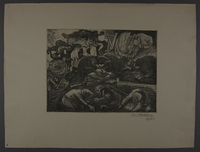
Leo Haas aquatint of frail people searching in the dirt
Object
Aquatint created by Leo Haas in 1966 based upon sketches made in 1942 based on scenes he witnessed while an inmate of Theresienstadt ghetto-labor camp. It depicts the desperate search for food by emaciated inmates of Theresienstadt ghetto-labor camp. Haas was an inmate of Terezin from September 1942-October 1944. Haas, 38, a Czech Jew and a professional artist, was arrested in 1939 in Ostrava in German occupied Czechoslovakia for begin a member of the Communist Party. He was deported to Nisko labor camp in Poland, then shipped back to Ostrava to do forced labor. In September 1942, he was sent to Theresienstadt ghetto-labor camp, where he became part of a tight knit group of artists determined to secretly document the conditions of daily life in the camp. In summer of 1944, they were accused by the Gestapo of smuggling their gruesome work out of the camp. Haas was arrested and tortured. In October, he was deported to Auschwitz, and a month later, to Sachsenhausen. In February 1945, he was transported to Mauthausen and then Ebensee. He was liberated there on May 4-5 by American troops.
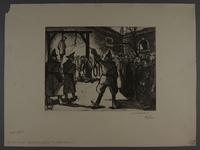
Leo Haas aquatint of prisoners assembled to view a hanging
Object
Aquatint created by Leo Haas in 1966 based upon sketches made in 1942 based on scenes he witnessed while an inmate of Theresienstadt ghetto-labor camp. It depicts inmtes witnessing a hanging in the courtyard of Theresienstadt ghetto-labor camp. Haas was an inmate of Terezin from September 1942-October 1944. Haas, 38, a Czech Jew and a professional artist, was arrested in 1939 in Ostrava in German occupied Czechoslovakia for begin a member of the Communist Party. He was deported to Nisko labor camp in Poland, then shipped back to Ostrava to do forced labor. In September 1942, he was sent to Theresienstadt ghetto-labor camp, where he became part of a tight knit group of artists determined to secretly document the conditions of daily life in the camp. In summer of 1944, they were accused by the Gestapo of smuggling their gruesome work out of the camp. Haas was arrested and tortured. In October, he was deported to Auschwitz, and a month later, to Sachsenhausen. In February 1945, he was transported to Mauthausen and then Ebensee. He was liberated there on May 4-5 by American troops.
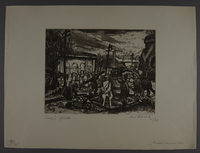
Leo Haas aquatint of prisoners constructing railroad lines
Object
Aquatint created by Leo Haas in 1966 based upon sketches made in 1945 shortly after the end of the war. After Haas arrived in Theresienstadt ghetto-labor camp, he was assigned to a crew that carted supplies for building the railway. Haas was an inmate of Terezin from September 1942-October 1944. Haas, 38, a Czech Jew and a professional artist, was arrested in 1939 in Ostrava in German occupied Czechoslovakia for being a Communist. He was deported to Nisko labor camp in Poland, then shipped back to Ostrava to do forced labor. In September 1942, he was sent to Theresienstadt ghetto-labor camp, where he became part of a tight knit group of artists determined to secretly document the misery and suffering of daily life in the ghetto. They hid their work in the camp, and much was recovered postwar. In summer 1944, they were accused by the Gestapo of smuggling their 'gruesome' work out of the camp and were arrested and tortured. In October, Haas was deported to Auschwitz, and a month later, to Sachsenhausen. In February 1945, he was transported to Mauthausen and then Ebensee. He was liberated there on May 4-5 by American troops.

Leo Haas aquatint of an SS dog following a line of weary prisoners
Object
Aquatint created by Leo Haas in 1966 based upon sketches made in 1942 based on scenes he witnessed while an inmate of Theresienstadt ghetto-labor camp. It depicts an SS dog guarding a line of exhausted prisoners being deported to camps in the east, an almost certain death. Haas was an inmate of Terezin from September 1942-October 1944. Haas, 38, a Czech Jew and a professional artist, was arrested in 1939 in Ostrava in German occupied Czechoslovakia for being a Communist. He was deported to Nisko labor camp in Poland, then shipped back to Ostrava to do forced labor. In September 1942, he was sent to Theresienstadt ghetto-labor camp, where he became part of a tight knit group of artists determined to secretly document the misery and suffering of daily life in the ghetto. They hid their work in the camp, and much was recovered postwar. In summer 1944, they were accused by the Gestapo of smuggling their 'gruesome' work out of the camp and were arrested and tortured. In October, Haas was deported to Auschwitz, and a month later, to Sachsenhausen. In February 1945, he was transported to Mauthausen and then Ebensee. He was liberated there on May 4-5 by American troops.
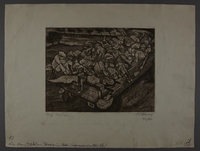
Leo Haas aquatint of a truck overloaded with the sick, dying, and dead
Object
Aquatint created by Leo Haas in 1966 based upon sketches made in 1942 of scenes he witnessed while an inmate of Theresienstadt ghetto-labor camp. It depicts the large bed of a truck overloaded with dead, dying, and ill inmates. Haas was an inmate of Terezin from September 1942-October 1944. Haas, 38, a Czech Jew and a professional artist, was arrested in 1939 in Ostrava in German occupied Czechoslovakia for being a Communist. He was deported to Nisko labor camp in Poland, then shipped back to Ostrava to do forced labor. In September 1942, he was sent to Theresienstadt ghetto-labor camp, where he became part of a tight knit group of artists determined to secretly document the misery and suffering of daily life in the ghetto. They hid their work in the camp, and much was recovered postwar. In summer 1944, they were accused by the Gestapo of smuggling their 'gruesome' work out of the camp and were arrested and tortured. In October, Haas was deported to Auschwitz, and a month later, to Sachsenhausen. In February 1945, he was transported to Mauthausen and then Ebensee. He was liberated there on May 4-5 by American troops.
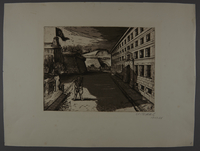
Leo Haas aquatint etching of a soldier watching marching people
Object
Aquatint created by Leo Haas in 1966 based upon sketches made in 1943 of scenes he witnessed while an inmate of Theresienstadt ghetto-labor camp. It depicts a lone soldier on guard in a deserted street watching prisoners leave the camp in the distance. Haas was an inmate of Terezin from September 1942-October 1944. Haas, 38, a Czech Jew and a professional artist, was arrested in 1939 in Ostrava in German occupied Czechoslovakia for being a Communist. He was deported to Nisko labor camp in Poland, then shipped back to Ostrava to do forced labor. In September 1942, he was sent to Theresienstadt ghetto-labor camp, where he became part of a tight knit group of artists determined to secretly document the misery and suffering of daily life in the ghetto. They hid their work in the camp, and much was recovered postwar. In summer 1944, they were accused by the Gestapo of smuggling their 'gruesome' work out of the camp and were arrested and tortured. In October, Haas was deported to Auschwitz, and a month later, to Sachsenhausen. In February 1945, he was transported to Mauthausen and then Ebensee. He was liberated there on May 4-5 by American troops.
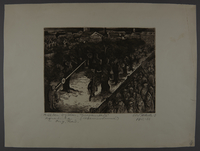
Leo Haas aquatint of new arrivals at the ghetto gate
Object
Aquatint created by Leo Haas in 1966 based upon sketches made in 1942 based on scenes he witnessed while an inmate of Theresienstadt ghetto-labor camp. It depicts a newly arrived transport of prisoners waiting at the ghetto gate. Haas was an inmate of Terezin from September 1942-October 1944. Haas, 38, a Czech Jew and a professional artist, was arrested in 1939 in Ostrava in German occupied Czechoslovakia for being a Communist. He was deported to Nisko labor camp in Poland, then shipped back to Ostrava to do forced labor. In September 1942, he was sent to Theresienstadt ghetto-labor camp, where he became part of a tight knit group of artists determined to secretly document the misery and suffering of daily life in the ghetto. They hid their work in the camp, and much was recovered postwar. In summer 1944, they were accused by the Gestapo of smuggling their 'gruesome' work out of the camp and were arrested and tortured. In October, Haas was deported to Auschwitz, and a month later, to Sachsenhausen. In February 1945, he was transported to Mauthausen and then Ebensee. He was liberated there on May 4-5 by American troops.
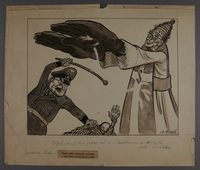
Two sided drawing by Leo Haas: Pope Pius XII blessing Himmler; Camp inmates at roll call
Object
Double-sided drawing created by Leo Haas with a satiric cartoon of Pope Pius XII blessing SS Chief Himmler on one side and a prisoner roll call at Mauthausen concentration camp where he was an inmate in spring 1945 on the other. For another version of this drawing see 2002.490.8. Haas, 38, a Czech Jew and a professional artist, was arrested in 1939 in Ostrava in German occupied Czechoslovakia for being a Communist. He was deported to Nisko labor camp in Poland, then shipped back to Ostrava to do forced labor. In September 1942, he was sent to Theresienstadt ghetto-labor camp, where he became part of a tight knit group of artists determined to secretly document the misery and suffering of daily life in the ghetto. They hid their work in the camp, and much was recovered postwar. In summer 1944, they were accused by the Gestapo of smuggling their 'gruesome' work out of the camp and were arrested and tortured. In October, Haas was deported to Auschwitz, and a month later, to Sachsenhausen. In February 1945, he was transported to Mauthausen and then Ebensee. He was liberated there on May 4-5 by American troops.

Leo Haas illustration of the Pope blessing Himmler for crucifying an inmate on barbed wire
Object
Watercolor created by Leo Haas depicting a satiric cartoon of Pope Pius XII, a kneeling Nazi with bloody hands, and a prisoner suspended on barbed wire, probably created for Eulenspiegel magazine where Haas was art director. Haas, 38, a Czech Jew and a professional artist, was arrested in 1939 in Ostrava in German occupied Czechoslovakia for being a Communist. He was deported to Nisko labor camp in Poland, then shipped back to Ostrava to do forced labor. In September 1942, he was sent to Theresienstadt ghetto-labor camp, where he became part of a tight knit group of artists determined to secretly document the misery and suffering of daily life in the ghetto. They hid their work in the camp, and much was recovered postwar. In summer 1944, they were accused by the Gestapo of smuggling their 'gruesome' work out of the camp and were arrested and tortured. In October, Haas was deported to Auschwitz, and a month later, to Sachsenhausen. In February 1945, he was transported to Mauthausen and then Ebensee. He was liberated there on May 4-5 by American troops.
Leo Haas aquatint of a funeral and a crowd watching an orchestra in Theresienstadt
Object
Aquatint created by Leo Haas in 1966 based upon sketches made in 1942 based on scenes he witnessed while an inmate of Theresienstadt ghetto-labor camp. It depicts a funeral in Theresienstadt ghetto-labor camp in 1942. Haas was an inmate of Terezin from September 1942-October 1944. Haas, 38, a Czech Jew and a professional artist, was arrested in 1939 in Ostrava in German occupied Czechoslovakia for begin a member of the Communist Party. He was deported to Nisko labor camp in Poland, then shipped back to Ostrava to do forced labor. In September 1942, he was sent to Theresienstadt ghetto-labor camp, where he became part of a tight knit group of artists determined to secretly document the conditions of daily life in the camp. In summer of 1944, they were accused by the Gestapo of smuggling their gruesome work out of the camp. Haas was arrested and tortured. In October, he was deported to Auschwitz, and a month later, to Sachsenhausen. In February 1945, he was transported to Mauthausen and then Ebensee. He was liberated there on May 4-5 by American troops.



